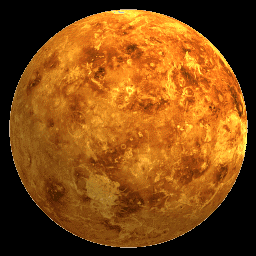
Venus
For a long time scientists have believed Venus to be Earth’s
twin. Venus and Earth are similar in size (diameter), mass, and
density, but besides those, Earth and Venus are very different
indeed. The reason it took scientists a long time to figure out
how Venus was different from Earth was because of the thick cloud
cover over it that has been there for around 400-800 million
years (1). The clouds on Venus are five times denser than those
on Earth and are made of carbon dioxide and sulfuric acid (1).
Sulfuric acid rains from these clouds and evaporates before it
even hits the surface of the planet (1). These clouds also keep
most of the heat from the Sun from escaping Venus’
atmosphere (which is made up of 97% carbon dioxide)(2), making
its surface temperature reach up to 480* C, the hottest planet in
the solar system (1). The high density of the atmosphere makes
the surface pressure of Venus 90 times greater than that of
Earth, which is why probes that have landed on its surface only
lasted a few hours before being destroyed (3). As well as
trapping in heat, the clouds on Venus also reflect sunlight (3).
This makes the planet very bright, and it is often the brightest
object visible in the sky, with the exception of the Sun and
Moon. (2).
On the surface Venus has deep canyons, craters, vast plains, and
some mountains caused by volcanoes (1). Much of the surface is
covered by vast lava flows (3). In the northern part of Venus is
a large, lava filled basin that’s bigger than the
continental United States called Ishtar Terra. Another large
feature of Venus is the Aphrodite Terra highlands that are more
than half the size of Africa and extend for almost 10,000 km (3).
Maxwell Montes is a volcanic mountain that sits at one end of
Ishtar Terra and is bigger than Mount Everest (3). There are also
several large channels on Venus caused by lava flows (1).
There are some very unique features on Venus aside from the ones
on the surface. Venus rotates around its axis very slowly, only
once every 243 Earth days. It orbits the Sun every 225 Earth
days, which makes its day longer than its year (3). Venus rotates
around its axis "backwards," or retrograde rotation,
which makes the Sun seem to rise in the west and set in the east.
Venus is 108 million km from the sun, has a 12,104 km diameter,
and has no moons.
